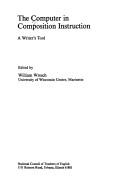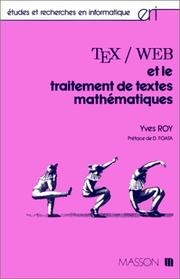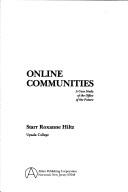| Listing 1 - 8 of 8 |
Sort by
|
Book
ISBN: 0880561041 Year: 1984 Publisher: Beaverton (Or.) : Dilithium press,
Abstract | Keywords | Export | Availability | Bookmark
 Loading...
Loading...Choose an application
- Reference Manager
- EndNote
- RefWorks (Direct export to RefWorks)
Book
ISBN: 0895882299 9780895882295 Year: 1984 Publisher: Berkeley Sybex
Abstract | Keywords | Export | Availability | Bookmark
 Loading...
Loading...Choose an application
- Reference Manager
- EndNote
- RefWorks (Direct export to RefWorks)
IBM Personal Computer --- Word processing --- Programming --- MultiMate.

ISBN: 0814108156 Year: 1984 Publisher: Urbana National council of teachers of English
Abstract | Keywords | Export | Availability | Bookmark
 Loading...
Loading...Choose an application
- Reference Manager
- EndNote
- RefWorks (Direct export to RefWorks)
English language --- Report writing --- Word processing in education --- Composition and exercises --- Data processing --- Rhetoric --- Computer-assisted instruction --- Study and teaching
Book
ISBN: 0697001849 Year: 1984 Volume: vol *3 Publisher: Dubuque W.C. Brown
Abstract | Keywords | Export | Availability | Bookmark
 Loading...
Loading...Choose an application
- Reference Manager
- EndNote
- RefWorks (Direct export to RefWorks)

ISBN: 2225802491 9782225802492 Year: 1984 Publisher: Paris: Masson,
Abstract | Keywords | Export | Availability | Bookmark
 Loading...
Loading...Choose an application
- Reference Manager
- EndNote
- RefWorks (Direct export to RefWorks)
Mathematics printing --- Computerized typesetting --- Computer programs --- -Printing --- Automated typesetting --- Computer typesetting --- Typesetting --- Word processing --- Data processing --- -Computer programs --- Mathématiques --- Impression --- Mathematics printing - Computer programs --- Latex (computer program)
Book
ISBN: 0306414473 1461296668 146132677X 9780306414473 Year: 1984 Publisher: New York (N.Y.) : Plenum press,
Abstract | Keywords | Export | Availability | Bookmark
 Loading...
Loading...Choose an application
- Reference Manager
- EndNote
- RefWorks (Direct export to RefWorks)
Management information systems --- 658 --- Management information systems. --- #KVIV --- 681.3*H41 --- 681.3*H42 --- Computer-based information systems --- EIS (Information systems) --- Executive information systems --- MIS (Information systems) --- Sociotechnical systems --- Information resources management --- Management --- Business management, administration. Commercial organization --- Office automation: equipment; word processing--See also {681.3*I7} --- Types of systems: decision support (e.g. MIS); logistics (Information systemsapplications --- Communication systems --- 681.3*H42 Types of systems: decision support (e.g. MIS); logistics (Information systemsapplications --- 681.3*H41 Office automation: equipment; word processing--See also {681.3*I7} --- 658 Business management, administration. Commercial organization --- 658 Zaakvoering, administrat --- Zaakvoering, administrat --- Systèmes d'aide à la décision --- Système d'information de l'entreprise --- Decision support systems

ISBN: 0893911453 Year: 1984 Publisher: Norwood (N.J.) Ablex
Abstract | Keywords | Export | Availability | Bookmark
 Loading...
Loading...Choose an application
- Reference Manager
- EndNote
- RefWorks (Direct export to RefWorks)
Communication in science --- Computer networks --- Interactive computer systems --- Telematics --- 681.3*H41 --- 681.3*I21 --- CMC systems --- Computer-mediated communication --- Telecommunication --- Cyberspace --- Computer systems --- Online data processing --- Communication systems, Computer --- Computer communication systems --- Data networks, Computer --- ECNs (Electronic communication networks) --- Electronic communication networks --- Networks, Computer --- Teleprocessing networks --- Data transmission systems --- Digital communications --- Electronic systems --- Information networks --- Cyberinfrastructure --- Electronic data processing --- Network computers --- Communication in research --- Science communication --- Science information --- Scientific communications --- Science --- Office automation: equipment; word processing--See also {681.3*I7} --- Applications and expert systems (Artificial intelligence). Cartography. Games. Industrial automation. Law. Medicine and science. Natural language interfaces. Office automation--See also {681.3*H4}; {681.3*J} --- Distributed processing --- 681.3*I21 Applications and expert systems (Artificial intelligence). Cartography. Games. Industrial automation. Law. Medicine and science. Natural language interfaces. Office automation--See also {681.3*H4}; {681.3*J} --- 681.3*H41 Office automation: equipment; word processing--See also {681.3*I7}
Book
ISBN: 0262181150 9780262256858 9780262681469 0262256851 0262681463 Year: 1984 Volume: 1983 Publisher: Cambridge, Mass.
Abstract | Keywords | Export | Availability | Bookmark
 Loading...
Loading...Choose an application
- Reference Manager
- EndNote
- RefWorks (Direct export to RefWorks)
This book addresses a fundamental software engineering issue, applying formal techniques and rigorous analysis to a practical problem of great current interest: the incorporation of language-specific knowledge in interactive programming environments. It makes a basic contribution in this area by proposing an attribute-grammar framework for incremental semantic analysis and establishing its algorithmic foundations. The results are theoretically important while having immediate practical utility for implementing environment-generating systems. The book's principal technical results include: an optimal-time algorithm to incrementally maintain a consistent attributed-tree of attribute grammar subclasses, allowing an optimizing environment-generator to select the most efficient applicable algorithm; a general method for sharing storage among attributes whose values are complex data structures; and two algorithms that carry out attribute evaluation while reducing the number of intermediate attribute values retained. While others have worked on this last problem, Reps's algorithms are the first to achieve sublinear worst-case behavior. One algorithm is optimal, achieving the log n lower space bound in nonlinear time, while the second algorithm uses as much as root n. space but runs in linear time.
Interactive computer systems --- Programming languages (Electronic computers) --- -Text editors (Computer programs) --- Computer programming --- 681.3*D22 --- 681.3*D26 --- Computers --- Electronic computer programming --- Electronic data processing --- Electronic digital computers --- Programming (Electronic computers) --- Coding theory --- Editors, Text (Computer programs) --- Computer programs --- Programming software --- Systems software --- Word processing --- Programming language semantics --- Semantics --- Computer systems --- Online data processing --- Tools and techniques: decision tables; flow charts; modules and interfaces; programmer workbench; software libraries; structured programming; top-down programming; user interfaces (Software engineering) --- Programming environments: interactive (Software engineering) --- Programming --- 681.3*D26 Programming environments: interactive (Software engineering) --- 681.3*D22 Tools and techniques: decision tables; flow charts; modules and interfaces; programmer workbench; software libraries; structured programming; top-down programming; user interfaces (Software engineering) --- Text editors (Computer programs) --- Interactive computer systems. --- Computer programming. --- Semantics. --- COMPUTER SCIENCE/Programming Languages
| Listing 1 - 8 of 8 |
Sort by
|

 Search
Search Feedback
Feedback About UniCat
About UniCat  Help
Help News
News